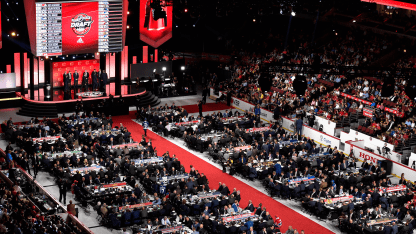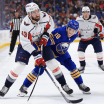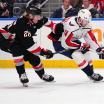For most of the last decade, the Washington Capitals have been making do with a shorter-than-average supply of draft choices, so having a total of just four picks in the NHL's 2017 Draft in Chicago over the weekend wasn't an unfamiliar situation. This summer marks the third time in the last seven drafts the Caps have had only four picks, the franchise's all-time low for total players chosen in a single draft.
Vogel's Take: Caps Bring Home Four Players from 2017 NHL Draft
Washington drafts three defenseman and a winger, with all four expected to participate in this week's summer development camp.

Not only did the Caps have only four choices in the 2017 Draft, their four picks came in the final four rounds of the draft. Washington's first choice was No. 120 overall, the latest "first" pick in Capitals franchise history.
"When you don't have a first, second or a third," says Ross Mahoney, Caps assistant general manager, "you obviously know there are a lot of good players who are going to be taken. But we were very happy with who was there when we picked in all the rounds."
Back in 2011, the Caps also had just four picks and didn't have their first choice until the fourth round. They chose Norwegian netminder Steffen Soberg at No. 117 overall that year. This summer, the Capitals tabbed left-handed shooting defenseman Tobias Geisser with their first choice in the draft, No. 120 overall. Washington has chosen Swiss players in three straight drafts now, having taken defenseman Jonas Siegenthaler in the second round in 2015 and forward Damien Riat in the third round in 2016.
"Tobias played on [Switzerland's] national teams," says Mahoney. "He was a captain of the U-18 team, so you have an opportunity to see him play in the major tournaments.
"He was a late cut on the U-20 team too, for the World Junior [Championship]. [He has] good sense, skates really well, good size. He actually played more forward than defense until a couple of years ago, so that was pretty intriguing to us also."
The 18-year-old Reisser played for the Zug EV team in Switzerland in 2016-17, splitting the season between the Swiss-B and Swiss-A levels. He is a native of Stans, Czech Republic.
A round later, the Caps stayed on the other side of the pond when they took lefty defenseman Sebastian Walfridsson with their fifth-round choice, No. 151 overall. The 18-year-old Walfridsson played for the MoDo junior team in Sweden in 2016-17.
"A good two-way defenseman," says Mahoney of Walfridsson. "A real character guy who played on the U-18 team in all the different tournaments. We thought in April at the World Championship that he was probably one of the more physical defensemen that they had on their team. They had the [Erik] Brannstsroms and the [Timothy] Liljegrens who went early in the draft, but we thought Sebastian was the perfect complementary guy to play with those two players."
In the sixth round, the Caps stayed on the blueline but came back to North America to choose Benton Maass, an 18-year-old defenseman from Elk River, Minn. A right-handed shot, Maass played for Fairbanks of the NAHL last season. Maass came to Washington with the No. 182 overall pick in the draft.
At Elk River High, Maass had the opportunity to play under head coach Gordie Roberts, an American-born defenseman who played nearly 1,100 NHL games and more than 300 WHA games over a playing career that stretched over two decades, from 1975-96.
"Anytime you have the opportunity to learn under a good player such as that I think it speeds up your development," says Mahoney. "We were happy with him. [Caps amateur scout] A.J. Toews really liked Benton Maass a lot. [He is] a right-handed defenseman that skates well, was captain of the team, and another guy with good character and good leadership. He actually went to the North American League after his season was over and performed even better, we thought, against older players in junior than at his high school, so I thought that was a positive also."
With their last pick of the draft, pick No. 213 overall, the Caps selected Norwegian left wing Kristian Roykas Marthinsen. He has spent the last two seasons playing in Sweden for the Almtuna Jr. and U-18 teams. Roykas Marthinsen turns 18 later this summer and is one of the youngest players chosen in the 2017 NHL Draft.
"Left winger, left-handed shot, strong, very good shot," begins Mahoney on Roykas Marthinsen. "He really impressed us at the U-18 in Slovenia. I think he had five goals in five games. But he's very powerful and he showed that he has very good ability to finish around the net."
Washington's philosophy has long been to take the best player available with each pick, regardless of position. So even though the Caps are as well-stocked on defense as at any position in terms of sheer number of players coming up through their system and through the ranks, they added three more blueliners this weekend.
"We've always had the philosophy of taking the best available player," says Mahoney. "It was interesting watching the expansion draft and seeing all the defensemen getting taken. We have taken some defensemen lately, but we will continue to take them if that's the best player available to you.
"I think that tends to be cyclical, too. Some years, you end up with more defensemen than others. You just don't want that thought of passing over a defenseman to take a winger and then that defenseman ends up being a much better player than the player you took. I'd rather take the best player, and that enables [general manager] Brian [MacLellan] to be able to do things. The better the prospects you have, the easier it is for him to be able to make some of these moves if he wants to, as opposed to not having prospects because you passed over certain players positionally."
Looking ahead to training camp this fall, it's very possible that the Caps will have a bit of a battle for berths on their blueline. Washington lost defenseman Nate Schmidt to Vegas in last week's expansion draft, and it seems unlikely that the Caps will be able to afford impending free agent blueliners Karl Alzner and Kevin Shattenkirk. Depending on what happens this summer in the trade and free agent markets, the Caps may have a couple of rookie defensemen pushing for spots in the lineup in 2017-18.
"They might be rookie defensemen with us, but some of the candidates have been playing pro already for a couple of years in the American League," notes Mahoney. "And they might have played already in the NHL if they weren't in an organization with such a strong (NHL) team with such a strong group of defensemen. We're quite confident that the guys that we have will be able to step up and play. Sometime, you have to be a rookie in the NHL and get the true experience, so we'll see how things play out. But we feel that we've accumulated some pretty good young defensemen over the years. If there are spots [available], then we'll let them come to camp and battle it out."
Left-handed blueliners Christian Djoos, Lucas Johansen and Jonas Sigenthaler are in the pipeline while right-handers Madison Bowey, Tyler Lewington and Connor Hobbs are all right-handers. Djoos, Bowey and Lewington are heading into their third seasons as pros in North America while the other three are expected to play their first pro seasons on this side of the Atlantic in 2017-18.
"We've got a varying degree of style and player in Hershey," Mahoney points out. "We've got Christian Djoos, who is very offensive and plays on the power play. A young fellow like Lucas Johansen would be the same; he's very cerebral and very smart, can quarterback the power play and skates very well. You've got a Connor Hobbs, who's got an absolute bomb for a shot and he had 31 goals this year. He can really shoot the puck, and physically he is pretty strong. And then Madison Bowey always has played a very good two-way game, and he's got good size and strength. Jonas Siegenthaler is a big-bodied player who plays really well one-on-one and is good defensively. When I look at Tyler Lewington, he is just all heart and character.
"Hobbs, Lewington and Bowey shoot right, which is three right-handed shots. You've got Siegenthaler, Johansen and Djoos, who are all left-handed shots. So it's not like we have all right-handed defensemen or we have all two-way defensemen for the future. We've got a pretty good group there as far as being two-way, more offensive, left shot, right shot, and guys who can play on the penalty kill or on the power play. It's nice to have those options with these younger guys coming up in the future."
Washington has had to make do with fewer than the standard seven draft choices in many recent drafts, and the Caps have had more than seven selections only once in the last 10 drafts. The Caps had 10 picks in the 2012 NHL Draft.
"I think some of that is cyclical and it depends on where teams are in their development," says Mahoney. "We went through years where we had two or three picks in the first round and nine or 11 picks overall. We were blowing the team up and we were rebuilding. Then you get to the situation we're in now where we have a really good team and we have a chance to try to make a run at it, and maybe win a Cup. You're probably not going to have as many picks because you're using those as assets to be able to acquire players that you want. You don't want to give up the players out of your lineup because they're contributing for you."
Mahoney has been at the controls for Washington on draft day for two decades now, and he's presided over some notable changes in how the game is played during that span. Those changes have also had an effect on some of the attributes scouts find appealing in young players.
"Character has always been huge for us, so obviously that's always stayed the same," says Mahoney. "But the rules changed and there was less hooking and holding through the neutral zone and less obstruction. I think it opened the doors up a little bit more for players who once wouldn't have been drafted or would have been drafted later, the smaller and faster players.
"You look at the speed of the game today and it's unbelievable. So I think size has changed a little bit. And we didn't every worry about size as much as we worried about strength. Some guys are 6-foot-3 and some guys are 6-foot-0, but that doesn't necessarily mean that the 6-foot-3 guy is stronger on his skates. I think smaller defensemen have a better chance of playing. With the speed of the game and how fast the forwards can get in on the defense, you really have to be able to skate and be able to think the game really quickly and have that escape-ability to elude the forecheck. You see more defensemen today who are 5-foot-11 or 6-foot-0 playing than there were 10 or 15 years ago when there were probably more of them who were 6-foot-3 or 6-foot-4. We'd love the 6-foot-4 guy, too, but he's got to be able to skate fast and think the game because things happen so fast in today's game."
Each of the four newest members of the Capitals' organization is expected to be in attendance at
the team's annual summer development camp
this week. A total of 33 players will take to the ice starting on Tuesday. Camp consists of daily on-ice sessions culminating in a scrimmage on Saturday morning, and it also includes off-ice work and activities, too.


















